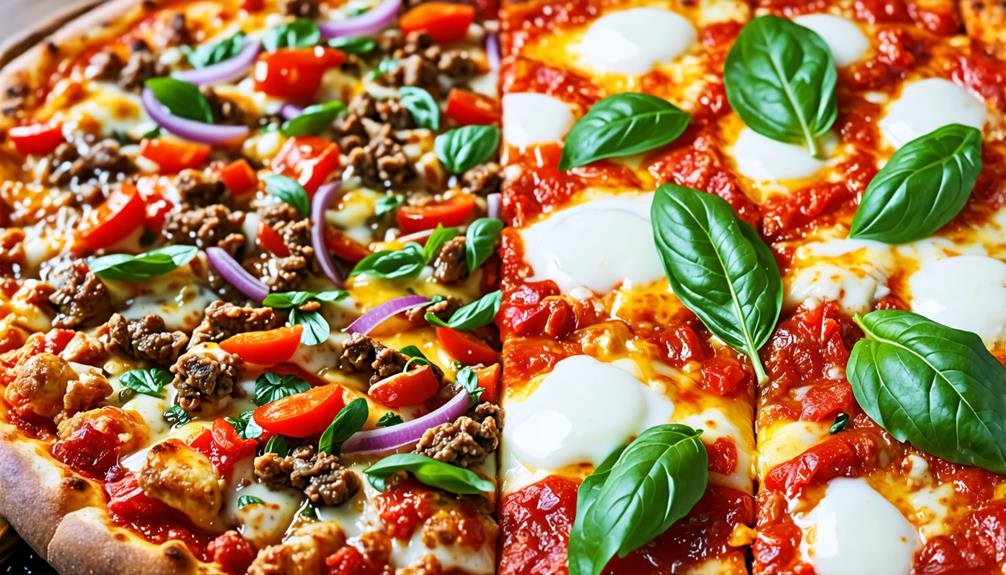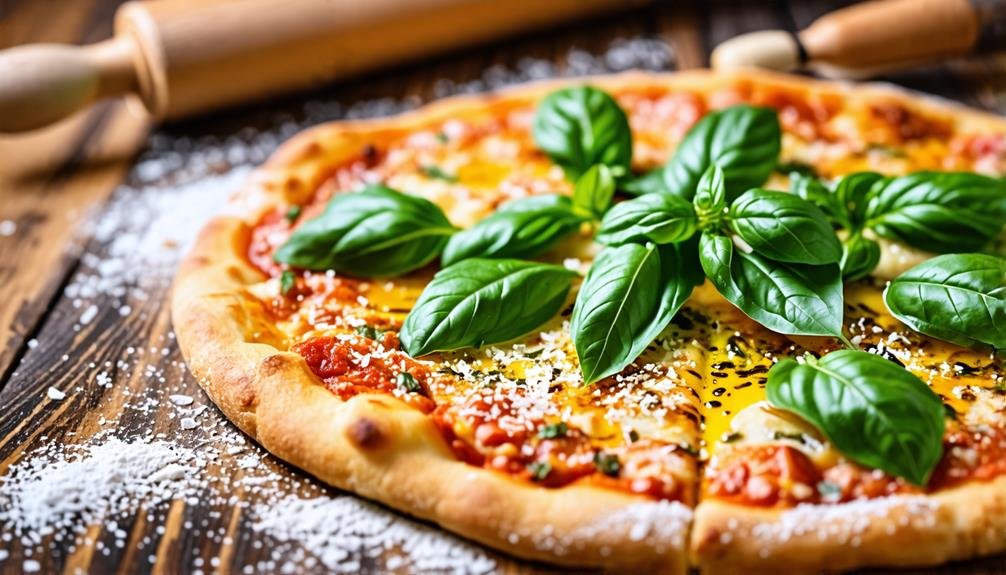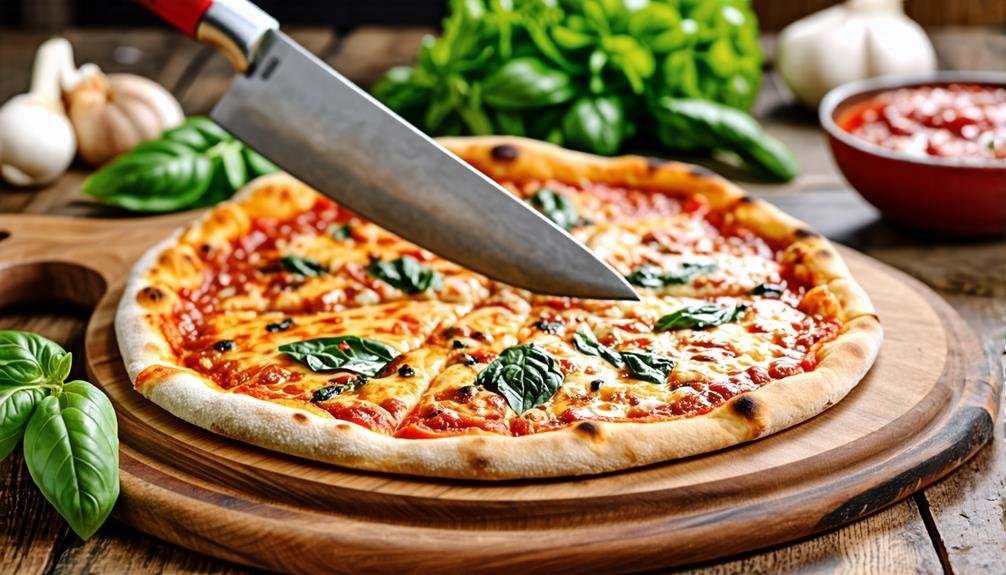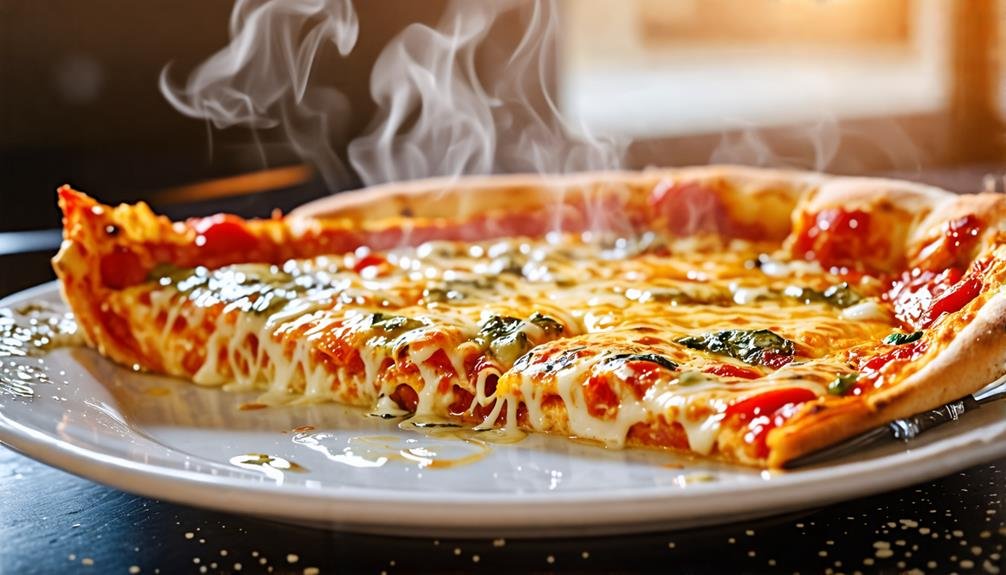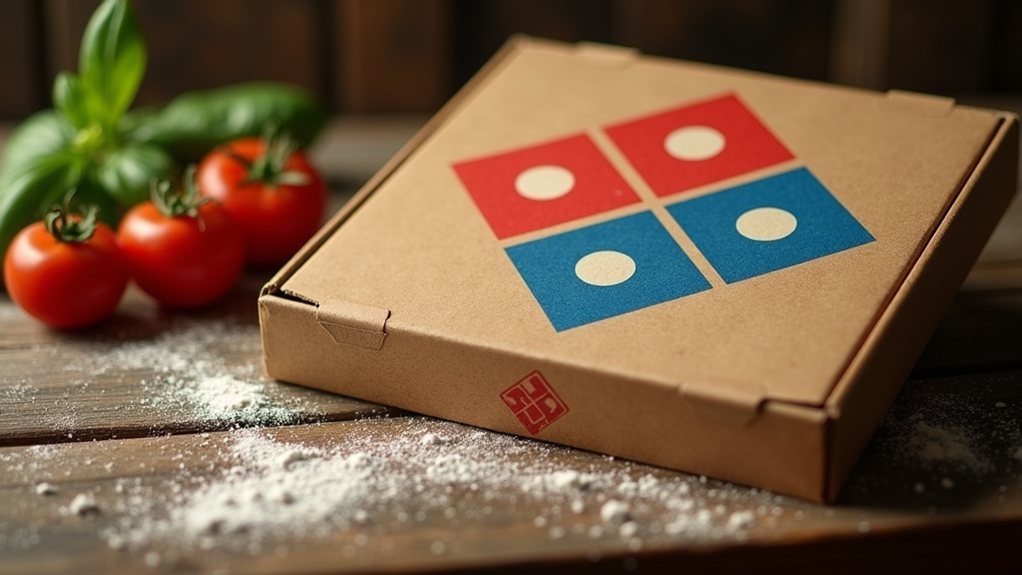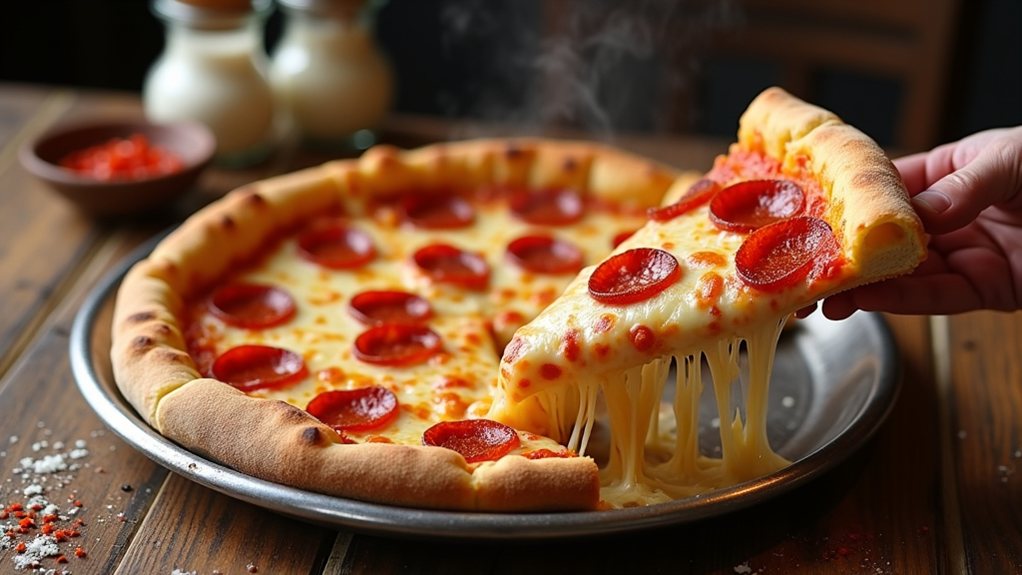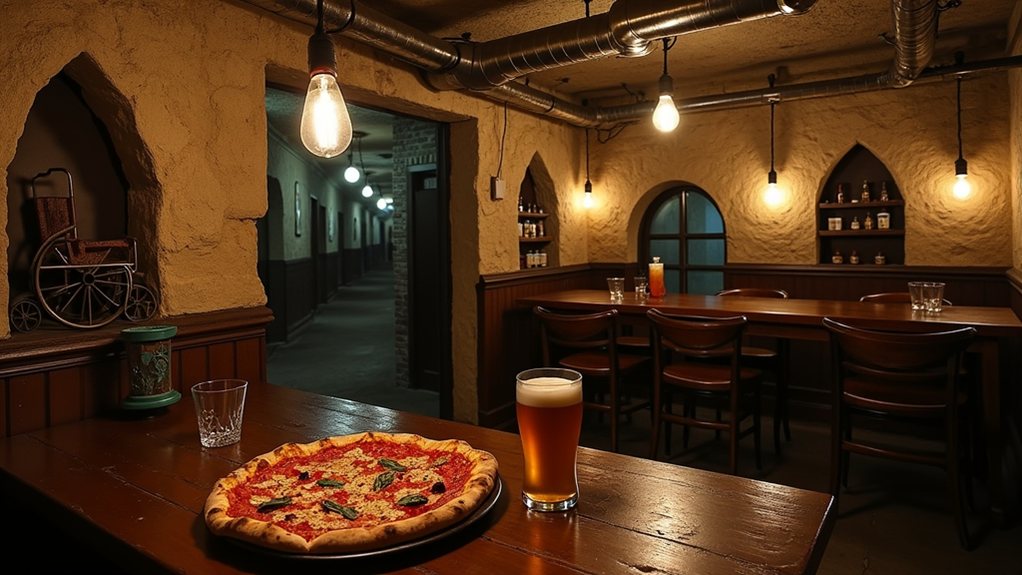Grilling frozen pizza presents a game-changing approach to summer barbecues, resulting in a crispy crust and enriched flavors that baking cannot replicate. To achieve ideal outcomes, preheat your grill and make sure the surface is clean and well-oiled. Different crust types require specific temperatures; for example, standard crusts grill best around 350°F, while thin crusts excel at higher settings. Enrich your pizza by adding fresh ingredients, such as vegetables or artisanal cheeses, which infuse smoky flavors. This method not only simplifies meal preparation but also enhances the dining experience, making it a valuable addition to summer gatherings. Delve into the possibilities further to refine your technique.
Why Grill Frozen Pizza?
Grilling frozen pizza delivers a distinct cooking approach that enhances flavor and texture, resulting in a crispy crust and a delicious smoky scent. Unlike traditional oven cooking, which can sometimes leave pizzas damp, grilling utilizes high, direct heat to achieve the perfect harmony between a crunchy base and gooey, melted cheese. This method shines during summer barbecues, where the outdoor grilling atmosphere elevates the enjoyment of a laid-back meal.
A key advantage of using a frozen pizza grill is the ease it offers. Simply preheat your Weber grill, set the frozen pizza on the grates, and let the heat do its work. This technique is not just efficient but also sparks creativity, allowing you to grill extra toppings like bell peppers or sausages alongside your pizza, imparting them with a delightful charred essence.
Furthermore, grilling frozen pizza can be a superb way to wow guests at summer gatherings, presenting an inventive twist on a beloved dish. By integrating these summer barbecue tips into your cooking skills, you can elevate a standard frozen pizza into a gourmet delight that pleases the taste buds and makes any barbecue unforgettable.
Preparing the Grill
Preparing the grill is a critical step to secure best results when grilling frozen pizza. Begin by preheating the grill to the appropriate temperature, as this will greatly influence the cooking process; for standard crust pizzas, aim for at least 350°F, while thin-crust varieties benefit from higher heat. Moreover, securing the grill surface is clean and well-oiled will help prevent sticking and promote even cooking, allowing the pizza to achieve a perfectly crisp crust.
Preheat Grill Properly
To achieve a delicious grilled pizza, start by properly preheating your grill, which is essential for optimal cooking conditions. The preheating stage is crucial, as it influences the crust's texture and flavor. Begin by igniting your grill, such as a Weber or Char-Broil, and setting it to a minimum temperature of 350°F. This heat level is perfect for traditional crust pizzas, allowing for even cooking that results in a crispy crust and melted cheese.
If you prefer thin-crust pizzas, you'll need to crank up the heat for that perfect crunch and to prevent any sogginess. It's important to give your grill enough time to reach the target temperature before placing the pizza on the grates; this typically takes about 10 to 15 minutes, depending on the grill model.
During the preheating process, keep the grill lid closed to maintain consistent heat, which aids in effective cooking. Proper preheating not only enhances the pizza's quality but also allows you to experiment with grilling various toppings, elevating your outdoor barbecue experience to new levels.
Choose Right Temperature
Selecting the correct temperature for grilling is essential for achieving perfectly cooked frozen pizzas. For optimal results, preheat your grill, like the Weber Spirit, to a minimum of 350°F. This temperature is ideal for standard crust varieties, allowing the crust to achieve a crunchy texture while ensuring that the cheese, such as mozzarella, melts evenly, resulting in a delightful fusion of flavors and textures.
If you prefer grilling thin-crust pizzas, such as those from DiGiorno, consider raising the heat. A higher temperature enhances cooking speed and provides a satisfying crunch. Keep a close eye on the grilling process, as thin crusts can cook rapidly and may burn if not monitored.
For larger or deep-dish pizzas, like those from Chicago Town, a lower temperature is advisable. These pizzas require more time to cook thoroughly without charring the outside. Aim for around 300°F and adjust your cooking duration accordingly. By mastering the intricacies of grilling temperatures, you can elevate your frozen pizza experience, transforming a simple meal into a flavorful grilled delight, embodying the spirit of summer barbecues.
Prepare Grill Surface
A clean and well-oiled grilling surface is essential for ensuring that frozen pizzas cook evenly and do not adhere during the grilling process. Before you start grilling, take the time to scrape off any leftover food particles from previous cookouts. This not only prevents unwanted flavors from seeping into your pizza but also helps prolong the grill's lifespan.
After cleaning, it's important to apply a thin layer of high-temperature cooking oil, such as canola or avocado oil, to the grill grates. This step significantly reduces the chance of sticking, allowing the pizza to release effortlessly when it's time to flip or take it off. Use a paper towel or a grill brush to spread the oil evenly; avoid using too much, as this can cause flare-ups.
Preheating the grill is another critical aspect of preparation. Ensure that your grill reaches the optimal temperature before placing the frozen pizza on the grates. This method guarantees a crispy crust and perfectly melted cheese, enhancing your overall grilling experience. By carefully preparing your grill surface, you lay the groundwork for a successful and enjoyable pizza grilling experience this summer.
Grilling Techniques for Different Crusts
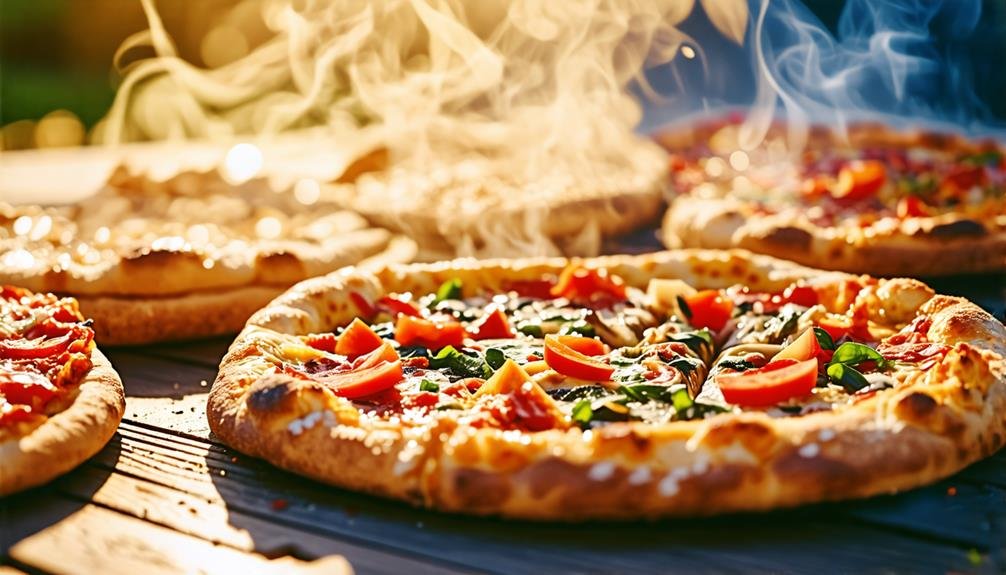
The type of pizza crust influences the grilling method significantly. Standard crust pizzas, like DiGiorno or Tombstone, thrive at grill temperatures of at least 350°F. This heat allows the crust to achieve a satisfying crispness while ensuring the cheese melts perfectly.
Thin-crust varieties, such as California-style pizzas, require higher temperatures, ideally above 450°F. This intense heat cooks the pizza quickly, creating a delightful crunch that locks in flavors without burning.
In contrast, deep-dish pizzas, like those from Lou Malnati's or Giordano's, pose unique challenges. Their thick crusts need lower grill temperatures and extended cooking times. This approach ensures the center is thoroughly cooked while avoiding an overly charred exterior. Careful monitoring during the grilling process is crucial to achieve even cooking.
Adding Flavor With Toppings
Improving the taste of grilled frozen pizza can be achieved through the careful selection and application of toppings. Ideal grilling toppings range from classic options like pepperoni and mozzarella to more adventurous choices such as roasted vegetables or artisanal cheeses. By using effective layering techniques and thoughtful flavor pairings, it can enhance the overall taste experience, ensuring a deliciously customized pizza that stands out on the grill.
Ideal Grilling Toppings
Grilling frozen pizza can elevate the taste and overall enjoyment of your meal. Using fresh ingredients enhances both the visual appeal and flavor. For example, colorful bell peppers, zesty red onions, and earthy mushrooms can be grilled alongside the pizza. These vegetables add a smoky flavor and a satisfying crunch.
Adding meats like Hormel pepperoni, Italian sausage, or grilled chicken breast creates a more filling option, enriching each bite with savory goodness. Experimenting with different cheeses can also lead to delightful outcomes; consider topping your pizza with fresh mozzarella or creamy burrata for a luxurious touch.
Incorporating herbs and spices, such as fragrant basil or a dash of crushed red pepper flakes, can further enhance the flavor and aroma of your dish. For a gourmet finish, drizzle a balsamic glaze or a zesty aioli over the pizza after grilling.
Ultimately, the secret to perfect grilling toppings is achieving a balance of flavors and textures while allowing your culinary creativity to flourish. By mixing various ingredients, your grilled frozen pizza can become a remarkable dish, ideal for summer gatherings.
Layering Techniques
Mastering layering techniques is essential for enhancing flavor and texture in grilled frozen pizza, like DiGiorno or Tombstone. Start with a layer of mozzarella cheese, which not only adds creaminess but also serves as a base for other toppings. Then, evenly distribute your selected toppings, ensuring a balanced flavor profile for every slice.
Incorporate moisture-releasing ingredients such as bell peppers or mushrooms, but place these atop sturdier options like pepperoni or sausage to avoid sogginess. For an extra flavor boost, sprinkle herbs like oregano or red pepper flakes between layers to infuse the pizza with aromatic notes.
Feel free to experiment with unconventional toppings like grilled zucchini or feta cheese, which can elevate the taste experience. A final layer of gouda or provolone on top can create a beautifully melted finish, enhancing the overall texture. By applying these layering strategies, you can turn a frozen pizza into a gourmet dish that will impress guests at any summer barbecue.
Flavor Pairing Suggestions
Enhance your grilled frozen pizza experience with these delightful toppings. Grilling not only cooks but elevates the flavor of your pizza, turning a simple frozen dish into a gourmet masterpiece. Here are some ideas:
- Fresh Basil: Adding fresh basil leaves delivers an aromatic freshness that pairs well with various sauces and cheeses.
- Sautéed Vegetables: Incorporate grilled bell peppers, onions, or mushrooms for a smoky depth that enhances both flavor and texture.
- Gourmet Cheeses: Try unique cheeses like goat cheese or feta for a tangy contrast that transforms your pizza beyond its frozen roots.
- Cured Meats: Opt for toppings like Prosciutto di Parma or spicy salami to introduce a savory richness that complements traditional tomato sauce perfectly.
Grilling Take-and-Bake Pizzas

Grilling take-and-bake pizzas offers a practical way to achieve a wonderfully crispy crust and enhanced flavor, perfect for outdoor gatherings. By selecting uncooked take-and-bake options from brands like DiGiorno or California Pizza Kitchen, you save prep time and elevate the taste. The intense heat from the grill imparts a unique smoky essence that sets grilled pizzas apart from traditional oven-baked ones.
To begin, preheat your gas or charcoal grill to a minimum of 350°F for classic crust varieties; thinner crusts may need even higher temperatures. Proper temperature management ensures the crust becomes delightfully crispy while the cheese melts to perfection, culminating in a mouthwatering dish.
Additionally, grilling allows for customization; you can sprinkle fresh toppings like bell peppers, onions, or pepperoni on your pizza, enhancing your culinary creation. Keep a close eye on the cooking time to prevent charring and secure a desirable golden-brown finish.
Reheating Leftover Pizza
Reheating leftover pizza on a Weber grill is a fantastic way to bring back its original crunch while warming the toppings evenly. Unlike a Samsung microwave, which often makes the crust soggy, grilling restores the pizza's texture and flavor, perfect for those who appreciate culinary creativity. Here's how to maximize your leftover pizza experience:
- Preheat the Weber to a medium heat, about 350°F, to ensure consistent cooking.
- Utilize a cast-iron skillet or aluminum foil to keep toppings in place while crisping the crust.
- Cover the grill with a lid to trap heat and melt the cheese thoroughly, enhancing the overall flavor.
- Monitor closely to prevent burning; ideally, aim for about 5-8 minutes of grilling time.
Benefits of Grilling Over Baking
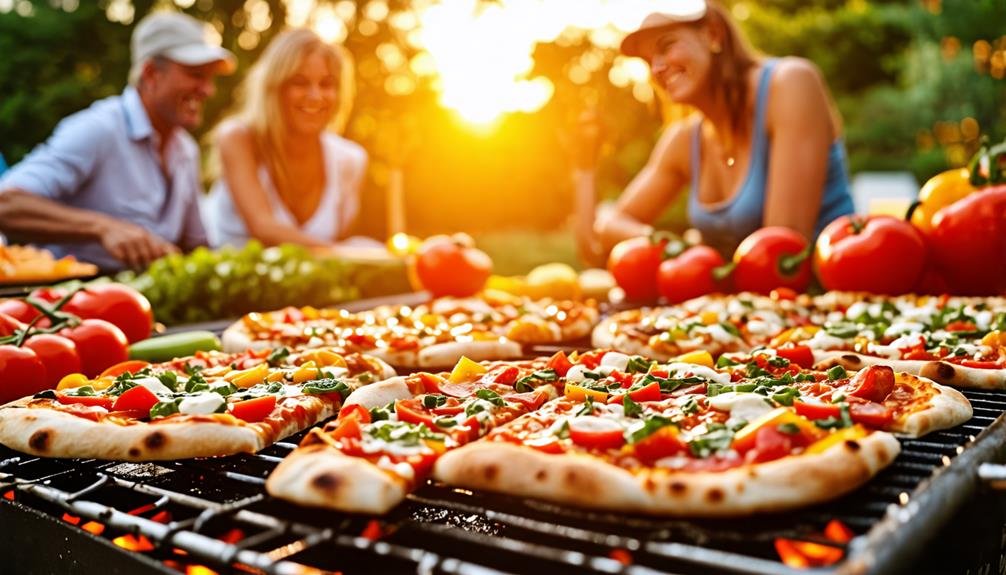
Grilling pizza offers notable advantages over baking, enhancing both flavor and texture. The direct heat from the grill produces a crispier crust, creating a satisfying crunch with each bite that ovens struggle to achieve.
Additionally, grilling imparts a smoky flavor to pizzas, a characteristic that baking can't replicate. The intense heat caramelizes the sugars in the dough and toppings, enriching the overall taste. This is particularly beneficial for brands like DiGiorno and Tombstone, as frozen pizzas gain a new level of character when grilled.
Moreover, grilling provides versatility in cooking methods and temperatures, accommodating various pizza styles. For instance, thin-crust pizzas can be cooked quickly at high heat, while thicker versions can be grilled at lower temperatures for even cooking without charring. Ultimately, grilling elevates frozen pizza into a delightful dining experience, perfect for summer cookouts and gatherings.
Tips for Large and Deep-Dish Pizzas
When grilling large and deep-dish pizzas, such as those from Giordano's or Lou Malnati's, it's crucial to pay attention to cooking times and temperatures to prevent burning. The size and thickness of these pizzas require a strategic approach for optimal results. Here are essential tips to improve your grilling experience:
- Preheat the Grill: Ensure your Weber or Char-Broil grill is preheated to a lower setting, around 325°F, to achieve even cooking without charring the crust.
- Utilize Indirect Heat: Place the pizza on one side of the grill while keeping the opposite side on high heat. This method allows for a gentle cooking process, similar to baking.
- Monitor Cooking Time: Regularly check the pizza, as larger varieties can take 25-35 minutes to cook thoroughly. Look for bubbling cheese and a golden-brown crust as indicators of doneness.
- Cover the Grill: Keep the lid closed as much as possible to create an oven-like environment, ensuring consistent cooking and avoiding flare-ups.
Elevating Your BBQ Experience
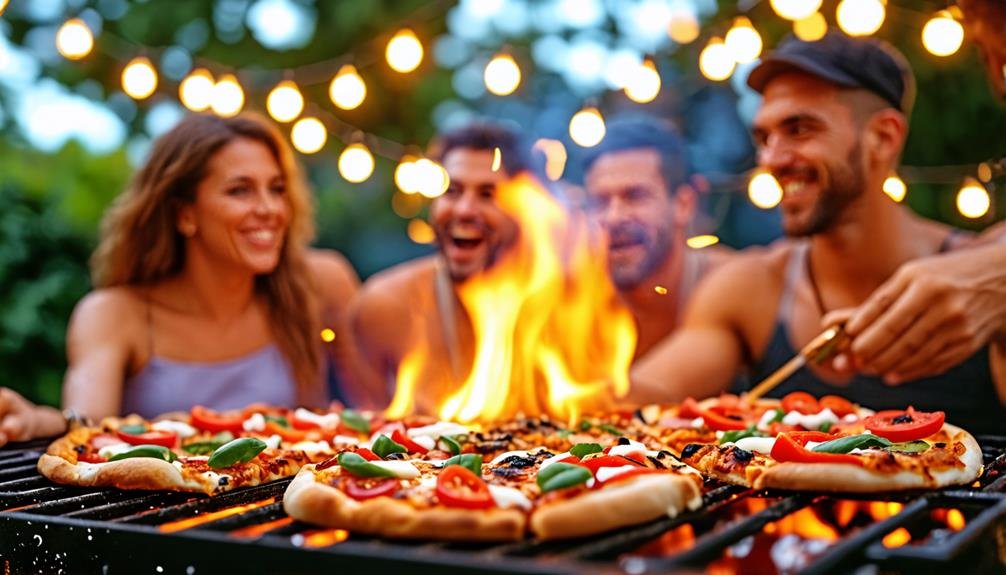
Elevating your BBQ experience involves enhancing outdoor cooking sessions with flavorful grilling techniques. Grilling frozen pizzas, like those from DiGiorno or Red Baron, transforms a simple meal into a gourmet delight, delivering a crispy crust and a smoky essence.
To optimize your BBQ, preheat your grill to the right temperature for your pizza type; a hotter grill suits thin crusts, while standard crusts perform best around 350°F. Consider grilling additional toppings, such as bell peppers or sausage, to create a customized flavor profile that caters to your taste.
Using take-and-bake pizzas from brands like California Pizza Kitchen allows for spontaneity during gatherings. Revitalizing leftover pizza on the grill keeps the crust crisp, avoiding the sogginess that often plagues reheating in the oven.
Ultimately, adopting these grilling methods can elevate your BBQ gatherings, offering a delicious culinary adventure that celebrates the joys of outdoor cooking. This summer, let your grill shine as the focal point of your gatherings, where creativity and flavor come together in every bite.


